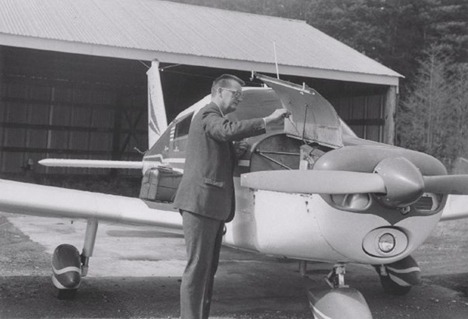By Fred Schumacher and Teresa DeGraaf
On D-Day, June 6, 1944, more than 1,600 American gliders launched from Chartres, France to land at Normandy.
According to a 1978 edition of the Journal of the San Juan Islands, parachute infantry surgeon Dr. Malcolm Heath rode in on the only surviving glider of a group of four.
At that moment, he likely imagined his death just a few minutes from landing. If he assumed his survival, he probably imagined a civilian life stateside, with a comfortable practice, out of harms way.
In reality, his landing at Normandy would be challenged in intensity by night flights to Bellingham, beach landings and house calls by boat, in all kinds of weather.
The Port of Friday Harbor, San Juan Pilots Association, as well as friends and patients will gather on March 27 to recognize Dr Heath’s contribution to the San Juan Islands.
Dr. Heath’s exhibit will serve as a memory for people who knew him, and an education for those who weren’t so fortunate. The display will remain in place for a year.
An unveiling reception is at 2 p.m. and is free and open to the public.
Dr. Heath’s post-war practice began in Boston.
By 1949, he was living on San Juan Island and was its only doctor.
He learned to fly, bought an airplane and a boat and stationed cars in Bellingham and on Orcas, as well as in Friday Harbor.
For more than 30-years he was the medical system for the San Juans, caring for all the families and for visitors alike.
He took calls at home at night, and visited patients dressed in a tie and jacket. He took the occasional fishing trip, but painted his boat pink, so that he could be found, if needed.
He delivered all the babies, escorted the hard cases to Bellingham, sutured the cuts, and calmed the families.
Many people share fond memories of his work, a few of those memories are shared here:
Norma Smithrud saw Dr. Heath from the time she was in the 4th grade.
When she grew up, he took care of her children.
Her memories include a night time emergency call, complete with jacket and tie. And the time, with his hand on her shoulder, he said, “Your family has been through so much.”
Al “H” said that Dr. Heath was, “A friend and damn fine doctor. Saved my life when I had malaria.”
Nancy (Nash) Hanson remembers Dr. Heath saving her father John from a bleeding ulcer and accompanying him on a night flight to Bellingham.
John lived a decade longer, saw three of his children married, and became a grandfather eight times over.
John Patz worked for Dr. Heath as a physician’s assistant and called him a “Marcus Welby” type.
He described calling a sick-at-home Dr. Heath for help with a patient with a bad laceration.
Heath was there in 45 minutes, wearing a shirt and tie, spent 20 minutes on the laceration — then, just said, “That was a bad one,” and headed home.
Dr. Heath attempted the delivery of Joyce Buffum’s four children.
Number four arrived during a strong windstorm. Unable to fly, Dr. Heath delivered the last child via the telephone at a church, guiding a nurse through the process.
Lynnette Guard remembers the birth of son, Frankie.
“He stopped by my home (on his way home) and as he looked out the window he said, “You can’t have the baby tonight, Lynette…It’s foggy.”
Margaret Mortenson worked as a pharmacist in Friday Harbor.
“I worked with Dr. Heath for a month or more without ever seeing him in person. I began to visualize him from his voice, a Southerner tinged with an English accent. One day a tall, athletic man with the demeanor of a person who had just jumped out of an airplane and repacked his chute right there in a grassy field strode into the drug store. Selma Stoney touched my sleeve and said, ‘that is Dr. Heath.’
He didn’t look any more like the man in my imagination than Princess Grace resembled Dr. Martin Luther King.”
Dr. Heath started the first EMT training program in 1974, and after his second retirement in 1980, he helped build the fire station at Hanna Heights.
Frank and Sandra Brame lived near him and had the pleasure of spending time at his home often in the 1980s.
There are big-city medical specialists who might say that a doctor who chooses to have a family practice out on a tiny island at the remote edge of northwest America must be in the witness protection program. The hours are long, the weather at times cruel, and the finances aren’t rewarding.
But many of those doctors work, retire and die without leaving a legacy like Dr. Heath.
To three decades of islanders, he was “The Doctor”. There are San Juan islanders today who might not have been born but for Dr. Heath’s saving a parent’s life.




